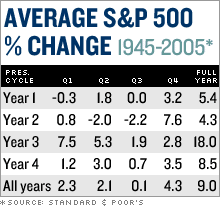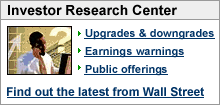For stocks: New quarter, more problemsThe market looks set to eke out a first-quarter gain but that may be it until the summer. Get ready for a rocky 2Q.NEW YORK (CNNMoney.com) -- If the Fed actually starts cutting rates this summer the way some investors seem to think, the third and fourth quarters could be decent on Wall Street. But until then, expect a lot of noise and not much action. Stocks surged on Tuesday after the Federal Reserve held interest rates steady and implied it was not likely to raise rates anytime soon and could even cut them later this year. (Full story).  
The most optimistic forecasts are for a cut as soon as June, while some economists think that if there is a cut at all, it won't happen until the end of the year. Still others note the Fed also signaled it's still very concerned about inflation, and therefore isn't likely to cut rates anytime soon. But let's say the Federal Reserve does cut rates as soon as this summer. The net result "could be an injection of euphoria, should the Fed start to lower in the second half," said Sam Stovall, Standard & Poor's chief market strategist, in the company's recent second-quarter outlook teleconference. That might be enough to counter things likely to weigh on stocks in the second half, like slower earnings and economic growth and the ongoing housing slump - including the recent fallout in the subprime mortgage market. But that's still three months away. Nearer at hand, the recent eight-month leg up in the 4-1/2 year-old bull market hit a major snag last month when a selloff in the Shanghai stock market spilled over to markets around the world. On that day, the Dow tumbled 416 points and saw its biggest one-day point loss in nearly 5-1/2 years. Since that time, the stock market has seesawed in reaction to signs of an economic slowdown and worries about defaults on subprime mortgages - home loans to buyers with weak credit. But the stock market has ended up recovering a good portion of what was lost. With one week left in March, the erratic first quarter should end up finishing with gains. That is, as long as typical end-of-quarter window dressing kicks in - when managers buy up the quarter's winners to goose their portfolios. As of Thursday's close, the Nasdaq and S&P 500 are both up less than 2 percent in 2007 while the Dow is roughly flat for the year. Any first quarter gains at all would be a good thing, because there are plenty of things to suggest the second quarter will be just as erratic as the first. The market was on a slow, steady path upward before the recent selloffs. That steadiness may not be recoverable anytime soon, according to Standard & Poor's. A recent S&P study found that typically when a period of relative calm - like the one Wall Street saw for 8 months - was interrupted, the three months and the year that followed were much more volatile. (Full story) "I think the big correction is over, but I also think it's going to get a lot choppier in the months ahead," said Neil Donahoe, chief investment officer at SYM Financial Advisors. Just as in the first quarter, the second could start off on a good note. After all, that adrenaline shot from the Fed should last a bit and April is typically a decent month for stocks. After that, it could get uglier. According to the Stock Trader's Almanac, April has been the best Dow month since 1950, good for a gain of 1.8 percent. For the S&P 500, it's the fourth best month, rising an average of 1.3 percent over that time. For the Nasdaq, April has been the fifth best month of the year, good for an average gain of 1 percent, going back to the tech-heavy index's inception in 1971. Computer hardware and software, Internet and healthcare stocks tend to outperform the broader market in April, May and June, according to the Almanac. First-quarter earnings pour in during the second half of April and anticipation about this tends to drive stocks higher. But, given widespread bets on Wall Street that first-quarter earnings are set to slow, that impact could be muted this year. Stocks typically do worse in the second half of the month after the income tax deadline has passed. In addition, the bevy of holidays - including Passover, Good Friday and Easter - means Wall Street attendance drops, making day-to-day swings in the market more dramatic. May is the Dow's fourth worst month of the year and is the fifth worst month for the S&P, with the averages managing only tiny gains. For the Nasdaq, May is in the middle, the sixth best month of the year since 1971, good for an average gain of 1 percent. May begins what the Almanac calls the "worst six months" of the year, and some investors use that as a reason to invest in the Dow between November and April and then switch to bonds between May and October to boost returns. In other words, the old "sell in May and walk away." May's weakness partly relates to the earnings aftermath. Although investors tend to buy in anticipation of earnings, once the earnings are out, the "sell the news" mentality tends to kick in. In terms of the main events, the May 9 Federal Reserve policy meeting tops the list. If the bankers are really going to start cutting rates in the summer, as some investors are hoping, the statement from this meeting could offer some hints. Then there's June, when tech stocks and the Nasdaq tend to do well. For the Nasdaq, June is typically a good month, the fourth best of the year since 1971, good for an average gain of 1.2 percent. But it's not as good for the blue chips. June is the Dow's second worst month of the year since 1950, with the blue-chip barometer losing 0.1 percent, on average. For the S&P 500 index, it's the fourth worst month of the year, with an average gain of 0.2 percent. Light trading volume tends to be an issue in June and the summer months, with investors focused more on the beach than the market. Lighter volume tends to bring more volatility and the potential for more losses. Investors hoping for good news - or at least the hint of good news to come later in the summer - will have to wait until the end of the month, with the next Fed policy meeting not until June 27-28. Subprime: the risk to Wall Street |
|



